Projects of RG Tezkan
Year | Funding | Title |
2021 – 2025 | BMBF-Project | DESMEX-real: Deep Electromagnetic Sounding for Mineral Exploration |
2021 – 2024 | DFG/NSFC | Sino-German Mobility Program: Numerical Modeling and Joint Inversion of Geophysical EM Fields |
2021 – 2023 | DFG-Project | Tensor 3D interpretation of CSRMT data with novel high-frequency sources considering displacement currents and anisotropy. |
2021 – 2023 | DFG-Grant | Subsurface imaging using the combination of magnetic and transient electromagnetic data at waste deposit site in Russia: Implications for environmental studies. |
2020 – 2024 | DFG-Project | CRC 1211: Earth - Evolution at the Dry Limit - Geophysical imaging of subsurface properties and magnetostratigraphy of sedimentary records |
2019 – 2022 | BMBF-Project | DESMEX-II: Deep Electromagnetic Sounding for Mineral Exploration |
2019 – 2021 | DAAD-Grant | Geo-electrical characterization of fault zones in the Himalayan foothills. |
2018 – 2020 | Volkswagenstiftung Project | Waste site Characterization using integrated transient electromagnetic and vertical gradient magnetic methods near Longerich to the northwest of Cologne, Germany. |
2017 – 2021 | DFG-Project | Interpretation of controlled source radiomagnetotelluric data in the frequency range 1 kHz - 1 MHz using multidimensional conductivity models. |
2018 – 2021 | DFG-Project | Kombinierte gitterfreie Modellierung und Inversion elektromagnetischer Daten |
2016 – 2020 | DFG-Project | CRC 1211: Earth – Evolution at the Dry Limit - Multi-dimensional modelling of Transient Electromagnetic data from the Atacama desert - Chile using seismic constraints. |
2015 – 2019 | BMBF-Project | DESMEX: Deep Electromagnetic Sounding for Mineral Exploration |
2013 – 2017 | DFG-Project | CRC-806: Multidimensional Joint Interpretation of TEM and ERT Measurements in the East-African Rift Valley |
2013 – 2017 | DFG-Project | Application of a novel marine EM Method to study sub-seafloor freshwater bodies |
2013 – 2017 | DFG-Project | Meshfree modelling of magnetotelluric and radiomagnetotelluric data: a new method. |
2012 – 2014 | Volkswagenstiftung Project | Electromagnetic (EM) methods to study the inner structure of mud volcanoes in Perekishkul, Azerbaijan |
2012 – 2014 | BMBF/TÜBITAK-Project | Two-Dimensional Joint Interpretation of Radiomagnetotelluric, Direct Current Resistivity and Induced Polarization Data; an example from an ore exploration |
2012 – 2016 | DFG-Project | Entwicklung und Anwendung eines neuen Inversionsprogramms für die Induzierte Polarisation im Zeitbereich in drei Dimensionen |
2009 – 2011 | DFG Project | AIDA: Unmanned Aerial System |
2009 – 2011 | DFG Project | Geotechnologien: Aero-Ground-Joint-Inversion |
2009 – 2013 | DFG-Project | CRC-806: Multidimensional Interpretation of Geoelectrical Data: Exploring the Structure of Sedimentary Basins in the Eastern Desert of Jordan |
2008 – 2012 | Deutsch-Israelische Wassertechnologie-Kooperation | Detection of fresh groundwater bodies within the Mediterranean submarine aquifers offshore Israel using marine geoelectric methods |
2009 – 2011 | DFG/Deutsch-Indische Kooperation | Groundwater contamination due to waste disposal and aquifer characterization around Roorkee using integrated Geoelectrical techniques |
2006 – 2010 | DFG-Project | Entwicklung und Anwendung eines Inversionsprogramms zur dreidimensionalen Rekonstruktion der Leitfähigkeit aus mehrkomponentigen TEM-Daten |

2021 – 2023, DFG Project, Tensor 3D interpretation of CSRMT data with novel high-frequency sources considering displacement currents and anisotropy
Electromagnetic and electric methods of applied geophysics are commonly used to study the conductivity structure of the shallow subsurface. In the past decades the radio-magnetotelluric (RMT) method has gained popularity and was successfully applied to various environmental, engineering, and other exploration problems. The conventional RMT method uses military and civilian radio transmitters broadcasting in the frequency range between 10 kHz and 1 MHz. A significant disadvantage of the traditional RMT method is the lack of robust high-frequency sources in remote areas. Another drawback is that there are no radio-transmitters broadcasting at frequencies below 10 kHz, which limits the penetration depth. To overcome these limitations, active and controlled-sources can be used instead of depending on remote radio-transmitter signals (CSRMT method, 1 kHz – 1MHz).
In few studies, the CSRMT method was successfully applied to shallow exploration. Both, horizontal magnetic (HMD) and horizontal electric dipoles (HED) were used. For time-domain applications a vertical magnetic dipole (VMD) source is common. Besides logistical and technical advantages and disadvantages, these sources generate different modes of currents in the ground and have different spatial-temporal shapes leading to different sensitivity patterns. As a consequence, different sources have different resolving power of the subsurface conductivity structures and can be utilized to derive improved models of the earth with respect to shape and geometry, resistivity amplitude, and, moreover, its directional dependence due to anisotropy.
Currently, no systematic and elaborate comparative studies of such CSRMT sources exist for the frequency band of 1 kHz – 1 MHz, including 3D numerical modeling and advanced field experiments. To tackle this gap in EM exploration, we propose the following objectives: (1) to develop source field strategies for optimal CSRMT surveying; our well-tested HED source will be further developed into VMD and HMD; (2) to derive improved subsurface models a novel 3D CSRMT modelling and inversion, based on the well-established ModEMM package, will be extended to all sources; (3) to take into account the displacement currents and (4) the anisotropy, the quasi-static ModEMM code will be further developed; (5) to validate the new sources, novel field experiments at two selected sites in Russia will be conducted. Analytical and numerical simulations shall be used to optimize surveying strategies and to study the resolution power of different sources. Existing robust CSRMT processing software will be used to derive full impedance tensor and tipper transfer functions. Subsequently, the field data will be inverted in 3D using the proposed improvements and implementations in the ModEMM algorithm. Accompanying sensitivity studies will validate the resolving power of the considered sources and quantify the improvements on the models, particularly with respect to anisotropy. This project is strongly linked to the DFG Project “Interpretation of controlled source radiomagnetotelluric data in the frequency range 1 kHz -1 MHz using multidimensional conductivity models” described further below.
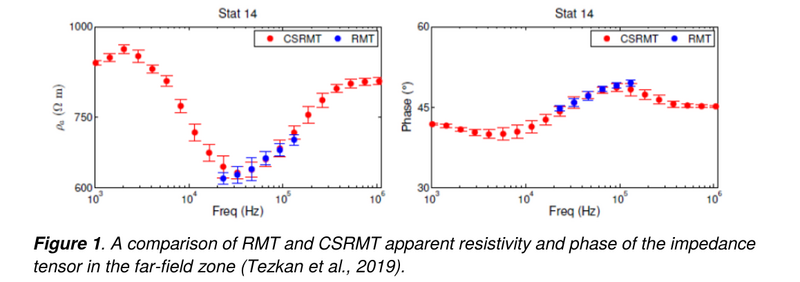

2021 – 2023, DFG-Grant: Subsurface imaging using the combination of magnetic and transient electromagnetic data at waste deposit site in Russia: Implications for environmental studies
The proposed research focuses on establishing an effective geophysical investigation strategy for a selected waste deposit site in St. Petersburg, Russia for solving serious environmental problems. Therefore, the integration of multiple geophysical techniques (magnetic, TEM, and CSRMT) will be used to characterize the studied landfill which may contain very different and complex contents. The propsed development of combined interpretation of novel TEM/CSRMT joint inversion together with magnetic data can decrease non-uniqueness and give an effective approach to map the conductive waste body and the ferrous materials inside it. This will lead to a better resolution of the model parameters of the landfill and its lateral and vertical extensions. The research will also focus on the determination of the possible contaminant in groundwater in the area of the landfill site. The results of the study will play a significant role in waste site risk evaluation for enviromental purposes.



2020 – 2024, DFG Project, CRC 1211: Earth - Evolution at the Dry Limit
Geophysical imaging of subsurface properties and magnetostratigraphy of sedimentary records
The subproject D07 “Geophysical imaging of subsurface properties and magnetostratigraphy of sedimentary records” is part of the Collaborative Research Center (CRC 1211). The aim of the CRC is to study arid to hyper-arid areas with regard to the evolution of the Earth’s surface, the climatical conditions and the biota. A driving force for the Earths evolutions are the paleo-climatical conditions. Evidence about the past climate can be often from coring ot excavations. Geophysical measurements can help to detect optimal locations for palaeoclimatological research.
This project is focussing on two different aspects; the use of magnetostratigraphy for age control of sedimentary records and the imaging of the subsurface with geophysical techniques. Our working group primary objective is the imaging of the subsurface on geophysical techniques at multiple scales and the development of a 2D inversion algorithm for subsurface imaging of Transient Electromagnetic (TEM) data using seismic data ofr example as structural constraints. To test the newly developed TEM inversion algorithm, TEM and seismic measurements are planned for 2021 in the Namib Desert, one of the driest and oldest areas on the Earth; at the Tsondab Vlei and Anrus clay pans and the Roter Kamm crater. In Fig. 1 a possible setup for the measurement at the Roter Kamm Crater is presented, with two long profiles crossing the whole crater and multiple individual measurement points evenly distributed within the survey area. Other key targets are located in the Atacama Desert/Chile and will be surveyed using multiple techniques.
More information on the project here

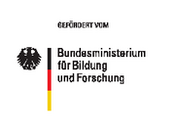

2019 – 2022, BMBF-Projekt, DESMEX-II: Deep Electromagnetic Sounding for Mineral Exploration
The overarching goal of the BMBF funded collaborative project DESMEX-II is the development of methods for efficient exploration of deposits at great depths (~1000 m). The sub-project of the University of Cologne (UoC) deals with the combined 3D inversion of ground-based and semi- airborne controlled source electromagnetic (CSEM) data. We focus on the integration of electric fields measured on the ground to improve the overall model resolution from semi airborne CSEM surveying. The combined inversion ground-based and semi-airborne CSEM requires the implementation of weighting functions for an optimal convergence of the large scale inversion schemes. Furthermore, a focus is the evaluation (data analysis and multi-dimensional Inversion) of semi-airborne CSEM data in the time domain, especially for drone based systems using a multicopter. One major focus is the investigation and integration of effects of the induced polarization (IP). This is particularly important when investigating for example mineral deposits. The aim here is to systematically simulate the effect of IP on semi-airborne CSEM data and also develop strategies to minimize (by adjusting survey parameters such as transmitter frequencies) or separate IP effects in semi-airborne CSEM. In a final step, IP parameters should be included in the derived 3D models of the electrical conductivity. If the IP Parameter can be successfully integrated, an improved evaluation and assessment of the investigated deposits is possible. Extensive ground-based CSEM, IP and semi-airborne CSEM measurements are planned in the frame of DESMEX-II.
In summer 2020, a large scale semi-airborne CSEM survey was conducted in a graphite mining area in Kropfmühl, Germany. At the ground, 7 horizontal electrical dipole transmitter with lengths between 1-3 km were deployed. As source signal, a rectancular current function with a 50 % duty cycle and a base frequency of 11.9 Hz was utilized. Sensors installed in a helicopter-towed bird measure the EM field on flight lines with a spacing of 250 m and within flight areas of 8x4 km, covering offsets of several km to the ground based transmitter. In addition, electric field stations were installed mainly along two N-S profiles, delivering complementary information about the electrical resistivity and IP parameters of the subsurface.
Further information:

2019 – 2021, DAAD Grant, Geo-electrical characterization of fault zones in the Himalayan foothills
Electrical and Electromagnetic techniques play central roles in the investigation of the subsurface related to thedetermination of the sediments thickness, their lateral and vertical boundaries, resistivity variation across andwithin the fault zone and their fluid saturation. The depth of investigation, accuracy and resolution of these toolscan be controlled by appropriate survey method and by conducting well planned surveys using optimum design parameters and survey geometry. The objective of the proposal is to apply the Transient Electromagnetic (TEM), Electrical Resistivity Tomography (ERT) methods integrated with the Magnetotelluric(MT) technique to investigate the electrical resistivity structure of the fault zone in Himalayan Frontal Thrust(HFT) around the Mohand area.
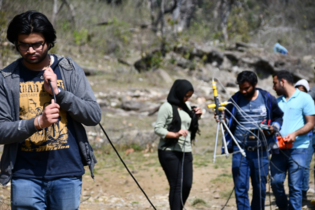
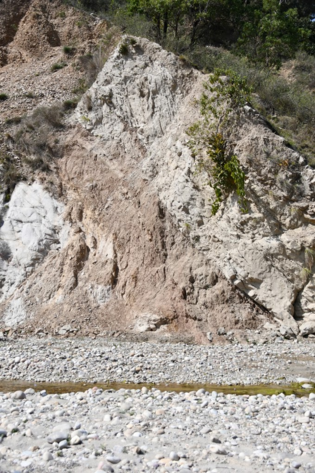
The study will be carried out in an area about 20 km south and 10 km north of Mohand in selected segments,preferably along profiles to delineate the electrical resistivity structure of the area at shallow to intermediate anddeeper depths. Data will be recorded at selected sites according to the availability of space in the field. It isexpected that the integrated application of TEM, ERT and MT method may resolve boundaries with a resistivitycontrast such as between the Piedmont Fault (PF) and the Indo-Gangetic Plain (IGP) in the south and PF andHFT in the northern region of the study area. The results shall be integrated to further develop the geologicalunderstanding and improving the geological map in this area.

2018 – 2021, DFG Project, Kombinierte gitterfreie Modellierung und Inversion elektromagnetischer Daten
In diesem DFG Projekt wird, im Gegensatz zu den klassischen numerischen Modellierungsverfahren wie denFiniten Differenzen (FD) oder der Finiten Elemente Methode (FEM), eine neue Interpretationssoftware zurmehrdimensionalen Modellierung (2D Inversion und 2D Vorwärtsmodellierung) geoelektrischer undelektromagnetischer Daten entwickelt. Diese beruht auf einem gitterfreien Verfahren zur Lösung partiellerDifferentialgleichungen und kommt ohne ein Diskretisierungsgitter aus. Das primäre Ziel diesesForschungsvorhabens ist es, den bereits im Rahmen einer Dissertation an der Universität zu Köln entwickelten,gitterfreien zweidimensionalen Vorwärtsalgorithmus für Interpretation magnetotellurischen Daten auf dieSimulation von gleichstromgeoelektrischen und elektromagnetischen Experimenten mit aktiven Sendern, zuerweitern. Weiterhin wird diese gitterfreie Methode in eine zweidimensionale Inversionsrechnung eingebettet,welche die Vorteile dieser speziellen gitterfreien Diskretisierung ausnutzt. Hierzu wird eine Joint-Inversionentwickelt werden, welche es ermöglicht Daten beider Methoden gleichzeitig zu invertieren und dadurch das soentstandene Untergrundmodell zu verbessern. Basierend auf einem neuen mathematischen Konzept zurMinimierung der auftretenden Kostenfunktionen innerhalb eines Gauss-Newton-Verfahrens werden die beidenunterschiedlichen Methoden in der Inversion gekoppelt. Das so entstandene Interpretationswerkzeug wirdanhand von synthetischen und reellen Datensätzen getestet und hinsichtlich auf Rechenlaufzeit und Genauigkeitoptimiert werden. Dadurch soll eine effektivere und präzisere Rekonstruktion von mehrdimensionalenLeitfähigkeitsverteilungen innerhalb der Erde aus kombinierten Datensätzen ermöglicht werden.

2018 – 2020, Volkswagenstiftung Project:
Waste site Characterization using integrated transient electromagnetic and vertical gradient magnetic methods near Longerich to the northwest of Cologne, Germany.
One of the most important and serious environmental problems is the buried waste site deposits. The project aims to use the geophysical techniques in order to characterize a dumpsite located at the northwest of Cologne, Germany and assess any possible environmental hazards resulted by the migration of the contaminants through developing a realistic 3D model of the waste site. Three different geophysical methods were applied; magnetic, Electric resistivity tomography (ERT), and transient electromagnetic (TEM). The magnetic survey was performed through three phases of field measurements between November 2018 and January 2019 to record the vertical gradient and the total magnetic field. Moreover, (ERT) measurements were carried out along eight 2D ERT profiles using Wenner and dipole-dipole arrays based on the results of the magnetic survey. Furthermore, time domain electromagnetic (TEM) measurements were also executed at 18 TEM stations. The aerial distributions of the dumpsite in the study area in addition to the base of the waste body have been determined. Very high local magnetic anomalies observed outside the waste site indicating possible unexploded ordinances (UXO) in the subsurface from the Second World War. Also, low resistivity zones below the boundaries of the waste site referring to possible pathways of contamination plumes downwards to the groundwater aquifer in the area of the landfill. A track of the buried gas pipe lines to the south of the landfill was also clearly detected.
Links:
https://www.earthdoc.org/content/papers/10.3997/2214-4609.201902492
https://gfzpublic.gfz-potsdam.de/rest/items/item_5001621/component/file_5002224/content
https://gfzpublic.gfz-potsdam.de/rest/items/item_5001618/component/file_5002223/content

2017 – 2021, DFG Project, Interpretation of controlled source radiomagnetotelluric data in the frequency range 1 kHz -1 MHz using multidimensional conductivity models
For many years, one of the research focuses of the University of Cologne and St. Petersburg State University have been development of radiomagnetotelluric (RMT) method. The current project was supported by DFG within the joint German-Russian project proposal call. One of the main objectives of the project is further advancement of the RMT method by extension of the frequency range using controlled sources (CSRMT). Additionally, tensor measurements are performed by utilizing two perpendicular transmitters. Within the project a 3D interpretation of the CSRMT data will be realized for the first time. The tipper transfer function along with the impedance tensor will be considered in order to improve spatio-lateral resolution of 3D geometries. One of the most challenging tasks is the development of the modeling procedure for near field CSRMT, where the source geometry must be taken into account. Two field surveys in Russia are planned. The first field experiment is aimed at technology testing and verification of the results. The test area is a paleo-valley in the vicinity of the village Alexandrovka, about 180 km away from Moscow. Since this object is also a test site of the Moscow State University, a lot of geophysical data and models are available, which can be used for verification of our results. The second survey area is a waste site near Kingisepp town (Saint-Petersburg region). The waste site was formed as a result of the chemical contamination (phosphate) from “Phosphorite factory”, which produces phosphate fertilizers and other chemical products. The soil and groundwater in the area near the landfill are contaminated as a result of melt and rainwater infiltration through the landfill body. Due to the heterogeneous structure, with conductive 2D and 3D targets, this test site is favourable for field studies.



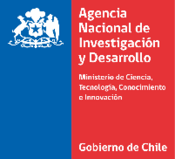
2016 – 2020, DFG Project, CRC 1211: Earth – Evolution at the Dry Limit
Multi-dimensional modelling of Transient Electromagnetic data from the Atacama desert - Chile using seismic constraints.
Geophysics is used as an essential tool within the 1st Phase of the Collaborative Research Centre (CRC -1211), particularly within subproject A02, entitled - Paleoclimate Proxies: Miocene to Recent Precipitation History of the Atacama desert. This subproject aims to reconstruct the chronology, weathering, and erosion of the basins formed in the Atacama Desert during the Quaternary-Miocene period. Therefore, essential information about the climatic and environmental history of the hyper-arid nucleus should be collected. This research is explicitly associated with the endorheic basins formed more than 10 million years ago along the Coastal Mountain Range in South America.
Two different surveys were carried out (October 2018 and December 2020) using different geophysical techniques, in order to provide detailed information about the sedimentary architecture and bedrock topography of selected claypans in the Atacama Desert-Chile. The focus is on applying and interpreting Transient Electromagnetic (TEM) data using different inversion techniques, in which multi-dimensional modelling shall be derived to create a faithful image of these claypans.
Other geophysical methods such as seismic and magnetics were also carried out to combine an interpretation of Seismic and Magnetic results with TEM outcomes. Besides the methodological developments, the objective of the presented geophysical survey was to derive suitable drilling locations for paleoclimatic research and better understand the deposition regime.
Links:
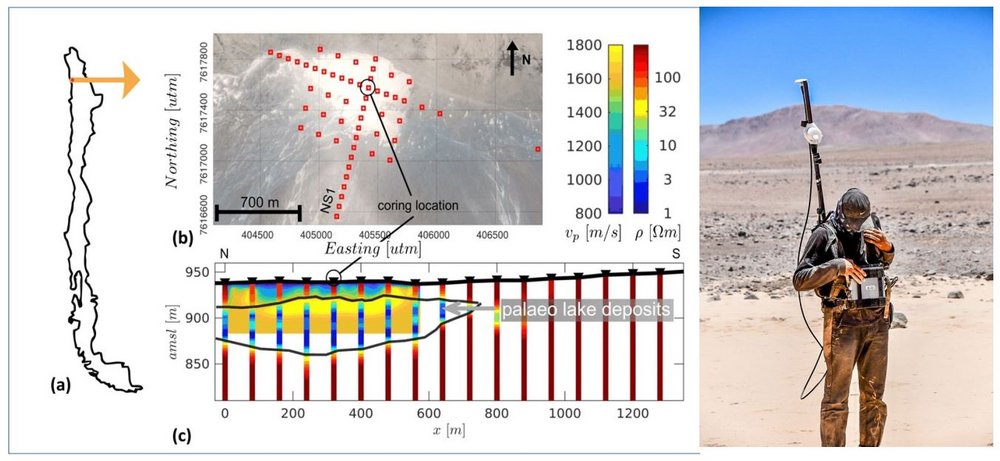



2015 – 2019, BMBF-Projekt, DESMEX: Deep Electromagnetic Sounding for Mineral Exploration
The overall objective of the BMBF funded DESMEX (Deep Electromagnetic Sounding for MineralExploration) project is the development of an electromagnetic exploration system which can be usedfor the exploration of mineral resources for depths up to 1000 m. In order to obtain a high coverage aswell as an high resolution, air borne and ground based methods are combined. In the framework ofDESMEX, the University of Cologne will carry out ground based (long offset) transient-electromagnetic(LOTEM) measurements in an old mining area in eastern Thuringia. Within the LOTEM validation study,an independent resistivity model of the survey area will be derived, which serves as reference modelfor the semi airborne concept and will eventually be integrated in a final mineral deposition model.
To define the geometry, grid and the transmitter/receiver settings of the LOTEM survey beforehand,one and two dimensional modeling studies are carried out, for which a good conducting ore veinembedded in more resistive host rocks is assumed. Within the modeling study, the thickness and thedipping angle of the ore vein as well as the resistivity of the neighboring rocks are varied. Ground based TEM and RMT measurements deliver first insights in the conductivity distribution of the survey area andare included in the modeling study.
In order to interprete the LOTEM dataset jointly, the inversion algorithm EMUPLUS will be extendedwith the forward calculation of the air borne EM data. The joint inversion will first be validated onsynthetic data and subsequently applied to the dataset of the main experiment. In order to derive arealistic model of the subsurface with respect to the source geometry of the LOTEM configuration andthe expected geometry of the mineral deposition formation, a multi dimensional inversion tool will beapplied to the dataset.

2013 – 2017, DFG-Project, CRC-806: CRC 806 - Our Way To Europe: Culture Environment Interaction and Human Mobility in the Late Quaternary
Multidimensional Joint Interpretation of TEM and ERT Measurements in the East-African Rift Valley
In the framework of the Collaborative Research Centre (CRC) 806 „Our way to Europe“, a geophysicalsurvey was conducted on sedimentary basins in southern and central Ethiopia. Combining geoscientificand archeological methods, the CRC 806 is designed to reconstruct the passageway of Modern Manfrom eastern Africa to central Europe over the last 200,000 years. The CRC is a multidisciplinary projectand investigates archaeological sites, terrestrial and aquatic archives in the source region of ModernMan, along trajectories of dispersal and in sink areas.In Nov./Dec. 2014 and in Feb./Mar. 2015, scientists of the work group of Applied Geophysics conductedtwo geophysical field campaigns in Ethiopia investigating three different sedimentary basins with2-dimensional Transient-Electromagnetics (TEM) assisted by Electrical Resistivity Tomography (ERT). Thevertical TEM component is used for the estimation of sediment thicknesses and stratigraphic layers.The horizontal TEM component will be used to study 2D effects generated by lateral resistivityvariations. The ERT measurements assist with the investigation of sediment thicknesses by jointlyinterpreting them with the TEM data.The Geophysical measurements and data analyses assist with the identification and definition ofpossible paleoenvironmental archives such as sedimental deposits with the aim of reconstructing thepaleoclimate, the determination of sediment thicknesses and the location of possible borehole sites.Acknowledgements: We thank the Institute of Geophysics, Space Science and Astronomy (IGSSA) ofthe University of Addis Ababa, Ethiopia, for the collaboration and the great assistance during ourfieldwork

2013 – 2017, DFG-Projekt: Application of a novel marine EM Method to study sub-seafloor freshwater bodies
In the framework of a DFG funded project, a novel marine electromagnetic method called Differential Electrical Dipole (DED) was developed and subsequently applied to study a sub-seafloor freshwater body. A measurement campaign was realized in April 2016 using the R/V Mediterranean Explorer from EcoOcean measuring at different stations along a 4 km profile near Bat Yam, Israel. The aim of the study is to test the feasibility of the marine DED method and to gain valuable information regarding the saltwater/freshwater interface at the western boundary of the sub-seafloor aquifer. The obtained data set is processed and interpreted in the framework of doctoral studies at the University of Cologne.

2012 – 2016, DFG-Projekt: Entwicklung und Anwendung eines neuen Inversionsprogramms für die Induzierte Polarisation im Zeitbereich in drei Dimensionen
Im Rahmen des von der Deutschen Forschungsgemeinschaft finanzierten Projekts „Entwicklung und Anwendung eines neuen Inversionsprogramms für die Induzierte Polarisation im Zeitbereich in drei Dimensionen“ wird zur Interpretation der Induzierten Polarisation im Zeitbereich die gesamte Zeitreihegenutzt.
Ziel ist die Entwicklung eines Algorithmus zur Inversion ganzer Zeitreihen in ein 3D Cole – Cole Leitfähigkeitsmodell.Hierzu werden die Transienten zu jedem Zeitpunkt mit einer 3D Geoelektrik – Inversion in einWiderstandsmodell invertiert. Der so erhaltene zeitabhängige Widerstand für jede Zelle lässt sichanschließend für jede Zelle in ein Cole – Cole Modell invertieren.
Um der benötigten hohen Datenqualität gerecht zu werden, kommt in diesem Projekt erstmals derneue Empfänger RIP 924 in Kombination mit dem Sender VIP 3000 zum Einsatz. Dies ermöglicht die Aufzeichnung des gesamten Transienten. Das neue Messsystem wird auf zwei Testflächen angewandt. Die Daten werden mit dem neuenInversionsalgorithmus ausgewertet.

2012 – 2014, Volkswagenstiftung: Electromagnetic (EM) methods to study the inner structure of mud volcanoes in Perekishkul, Azerbaijan
Three different electromagnetic methods were applied to study the inner structure of mud volcanoes atvarious depths in the Perekishkul region of Azerbaijan. The methods are capable of detectinggeotectonic boundaries and fault zones and are able to confine and improve structural models of themud volcanoes in the region.
Mud volcanoes have relevance to climate processes by means of methane out gassing that is likely tocontribute significantly to the global methane budget and therefore impacts the climate dynamics. Inaddition, mud volcanoes are often related to anticline uplifts and to large deposits of hydrocarbons.
During the first survey in April 2010 the Radiomagnetotelluric (RMT) method as well as the Transien t Electromagnetic (TEM) method were utilized in order to study the inner structures of the mudvolcanoes up to a depth of about 130 meters. The Long Offset Transient Electromagnetic (LOTEM)method was then applied during a second survey in September 2011. Resistivity structures up to adepth of 5 km were resolved.
For more information see poster EMTF 2011.

2012 – 2014, BMBF/TÜBITAK project
Two-Dimensional Joint Interpretation of Radiomagnetotelluric, Direct Current Resistivity and Induced Polarization Data; an example from an ore exploration
A new 2D algorithm will be developed for the joint interpretation of direct current resitivity (DCR), Radiomagnetotelluric (RMT) and Induced Polarization (IP) data during this project. The developed algorithm will be applied on geophysical data observed on a mining test area in the South of Turkey.
We are confident to show at the end that conductive and resitive structures can be better resolved by a 2D joint inversion result rather than by individual inversions of RMT and DCR data sets. The RMT method is sensitive to conductive structures while the DCR method is sensitive to resistive structures. While the DCR and RMT methods investigate the resitivity distribution, the IP method is used to resolve the chargeability properties of the subsurface. Therefore, all three methods are supporting each other and they will increase the overall significance of the subsurface model derived from their common physical parameter, i.e. electrical conductivity.
The main idea to be realized in our code is to do a 2D joint inversion of DCR and RMT data and then use the calculated 2D resistivity model in the 2D inversion of IP data. The first steps will be to develop a 2D DC/IP and a 2D RMT forward modeling algorithm with finite element method using unstructured mesh. This approach should help to incorporate surface topography and to consider sensitivity analysis and depth of investigation.
After the newly developed code was successfully tested on synthetic data, we will interpret real data, which we are going to acquire in field surveys on some mining areas from exploring Cu-Pb-Zn ±Ag ±Au mineralizations in Turkey.

2009 – 2013, DFG-project, CRC-806: Culture Environment Interaction and Human Mobility in the Late Quaternary
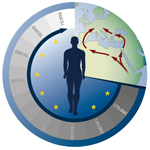
Multidimensional Interpretation of Geoelectrical Data: Exploring the Structure of Sedimentary Basins in the Eastern Desert of Jordan
The geophysical research takes place in the frame of the DFG funded Collaborative Research Centre 806 (CRC 806/ Sonderforschungsbereich 806) "Our Way to Europe: Culture Environment Interaction and Human Mobility in the Late Quaternary"
The CRC-806 concerns the history of mankind. It is designed to capture the complex nature of dispersal of Modern Man from Africa to Western Eurasia, and particularly to Europe. The CRC concentrates on the time span between the dispersal of Modern Man from Africa (190,000 B.P.) and the permanent establishment of Man in Central Europe (40,000 B.P.). The CRC is a multidisciplinary project and investigates archaeological sites, terrestrial and aquatic archives in the source region of Modern Man, along trajectories of dispersal and in sink areas.
The Eastern Mediterranean has been the passageway for human migration between Africa, the Middle East, the Balkans and Europe. The Azraq area, around the former oasis Qa' Al Azraq, in the eastern desert of Jordan has been a major spot for prehistoric settlements since the middle Pleistocene. Very promising archives for paleoclimatical reconstruction are sediment successions accumulated in dry clay lakes (Playa lakes).
We utilized the Transient Electromagnetic (TEM), the Direct Current Resistivity (DCR) and the Radiomagnetotelluric (RMT) methods to identify the most complete sedimentary sequences inside the mud?at Qa' Al Azraq and to derive suitable borehole locations for the paleoclimatical reconstruction.
Twodimensional interpretation of TEM-data ist not very common, as the computation of transient electromagnetic fields is very time expensive. However, to improve the geoelectrical models the TEM data will be interpreted in 2D.
For more information please visit: www.sfb806.uni-koeln.de or poster-emtf-2011


2009 – 2011, DFG Project, AIDA: Unmanned Aerial System
In addition to RMT ground data and existing TEM and helicopter-borne EM-data, we propose a new deployment of the so called Unmanned Aerial System (UAS), an innovative platform for airborne VLF/LF-measurements on
a regional scale. An UAS shall be utilized to perform geophysical surveys on a flying measuring platform. The utilization of UAS enables the performance of a time and cost-effective measuring platform to acquire high resolution images of geophysical parameters of electrical conductivity. Since many decades, VLF-measurements are a well established method in exploration geophysics on the ground as well as in airborne geophysics. These qualitatively provide an indication about lateral changes of the electrical conductivity of the ground.
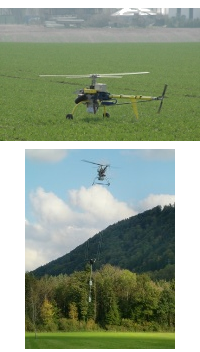
An innovative electromagnetic induction coil system will also be applied, which measures the EM field of VLF/LF and radio transmitters over a broad range of frequencies (10 kHz to 250 kHz). In 2008, METRONIX GmbH released an induction coil triple, the so called Super High Frequency Triple (SHFT)-sensor, which enables sensing the radiated magnetic field of VLF/LF-transmitter stations. This sensor was already deployed in a Swedish airborne geophysical survey performed by Pedersen und Dynesius (2008). This method allows determination of the electromagnetic impedance tensor over a large depth range and yields images of complex 3D conductivity structures. Finally, a transform function is used to derive the electrical conductivity from the magnetic field measured at different evaluation frequencies. According to the number of radio stations, many evaluation frequencies are available at a site, which considerably improves the depth resolution and is a significant advantage of this method. In addition, UAS's have the potential to open new possibilities concerning the organisation and performance of geophysical exploration.
For more information please see the poster-emtf-2011.


2009 – 2011, DFG Project, Geotechnologien: Aero-Ground-Joint-Inversion
In this sub-project it is intended to enhance the resolution of model parameters through the development of a joint inversion algorithm for helicopter-borne electromagnetic (HEM), transient electromagnetic (TEM), and radiomagnetotelluric (RMT) data sets. The proposed concept of the joint inversion takes advantage of each single method, which in most cases consists of a dense measuring grid (HEM and RMT) and on the other hand provides the capability to resolve near surface (RMT) and deeper electrical conductivity structures (TEM). HEM-, TEM-, and RMT-measurements are widely used in practical environmental, geotechnical, and exploration problems.
Helicopter-borne electromagnetic (HEM) measurements are an effective way to map the electrical conductivity of large areas. The typical scenario is first to identify the geophysical property that is diagnostic of the sought geological structure or buried object. The map, however, presents no information about the depth of the object or details regarding its shape. The depth of investigation of HEM-data is rather limited compared to EM sounding methods on the ground. In order to improve the accuracy of model parameters of shallow depth as well as of the deeper crust, we plan to combine HEM, TEM, and RMT measurements by using numerical joint inversion methodology. However, in most cases, the measuring grids of each single method will not overlap with each other. Therefore a reduction of all measuring grids to one grid requires either an interpolation algorithm or the introduction of smoothing conditions in the parameter space. Such algorithms are not available at present and shall be realized in this project. At the moment, there is no inversion method which enables the joint interpretation of HEM-, TEM-, and RMT-data.

2009 – 2011, DFG/ Deutsch-Indische Kooperation
Groundwater contamination due to waste disposal and aquifer characterization around Roorkee using integrated Geoelectrical techniques
Objectives of the Project:
The objective of the proposal is to apply the radiomagneto-telluric (RMT) technique by using a recently developed device integrated with Electrical resistivity tomography (ERT), and Time domainelectromagnetic (TEM) methods for the first time in India for environmental studies. The impact of current practice forwaste disposal used in Roorkee area on roundwater will be accessed. This will lead to the development of efficient and economic tools for monitoring the groundwater conta-mination and delineation of flow path of contaminants. Quantitative interpretation of resistivity data and its correlation with the lithological formation in the area will be used to define a water table elevation map and will be used as an indicator for the local groundwater flow direction.
There is a risk of groundwater contamination due to surface runoff from landfills around waste disposal site. Present proposal will focus on the determination of impact of contaminant in groundwater, geological medium underlying the landfill site, hydrological condition of the area and the effect of irrigation return-flow. A detailed planned systematic geophysical investigation will be carried out at selected sites in the vicinity of waste disposal site and a far uncontaminated remote site.
Aquifer model relating the electrical parameters and hydraulic parameters (transmissivity) of the aquifer will be developed for the Roorkee area using the results of the investigations and available pumping test data.
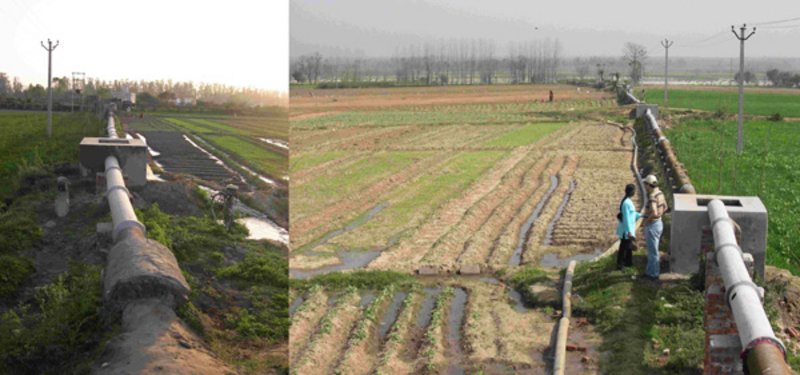

2008 – 2012, Deutsch-Israelische Wassertechnologie-Kooperation
Detection of fresh groundwater bodies within the Mediterranean submarine aquifers offshore Israel using marine geoelectric methods
Vorhabensbeschreibung - Zusammenfassung:
Die Erkundung von Süßwasseraquiferen unter den Flachmeeren stellt weltweit ein aktuelles Forschungsgebiet dar. Solche untermeerischen Süßwasservorkommen von einigen Metern bis hin zu einigen Kilometern vor der Küste- existieren weltweit (z. B. vor den Küsten der Niederlande, New Jerseys, der USA usw.).
Der Küstenaquifer am Mittelmeer in Israel ist eine wichtige Grundwasserquelle. Neue elektromagnetische Messungen auf dem Land zeigen die Existenz einer relativ schlecht leitenden Schicht unter dem mit Meerwasser kontaminierten Aquifer. Die vorhandenen Bohrungen zeigen, dass diese Schicht Süßwasser beinhaltet und es ist anzunehmen, dass sie sich untermeerisch fortsetzt. Ihre Tiefe und ihre laterale Dimension können mit marinen elektromagnetischen Methoden detektiert werden.
Das Hauptziel des Vorhabens ist die Erkundung des Aquifers unter dem Mittelmeer an der israelischen Küste mit elektromagnetischen Verfahren. Dabei wird die Long-Offset-Transient-Elektromagnetik- (LOTEM-) Methode in diesem Projekt erstmalig für marine Untersuchungen eingesetzt. Auf dem Land werden die Messungen mit einer Kombination von LOTEM und Short-Offset-Transient-Elektromagnetik (SHOTEM) durchgeführt, damit die Fortsetzung des Aquifers vom Land zum Meeresgrund erkundet werden kann. Mit Hilfe der erzielten geophysikalischen Ergebnisse wird eine optimale hydrogeologische Modellierung durchgeführt, um das Wassermanagement in der untersuchten Region zu verbessern.

2006 – 2010, DFG-Projekt: Entwicklung und Anwendung eines Inversionsprogramms zur dreidimensionalen Rekonstruktion der Leitfähigkeit aus mehrkomponentigen TEM-Daten
Transientelektromagnetische (TEM) Verfahren werden zur Erforschung des Untergrundes, wie beispielsweise zur Erkundung von Lagerstätten oder Frischwasser aber auch zur Beantwortung geologischer Fragestellungen und im Umweltbereich zunehmend eingesetzt. Die rasch fortschreitende Entwicklung im Bereich der elektromagnetischen Tiefenforschung erlaubt es, dass TEM Messungen verstärkt auf dreidimensionale Fragestellungen angewandt werden. Für eine dreidimensionale Interpretation der gewonnenen TEM-Daten fehlt jedoch bislang eine geeignete Inversionssoftware. Das primäre Ziel dieses Forschungsvorhabens ist es, die vom vorgesehenen Projektbearbeiter bereits erstellte aber noch experimentelle Interpretationssoftware fertig zu stellen, um mittels moderner Inversionstechniken eine dreidimensionale Leitfähigkeitsverteilung aus TEM-Daten zu rekonstruieren. Das Interpretationswerkzeug soll auf reale Daten eines TEM-Verfahrens zur oberflächennahen Erkundung des Untergrundes eingesetzt werden, welches am Institut für Geophysik und Meteorologie der Universität zu Köln entwickelt wird.